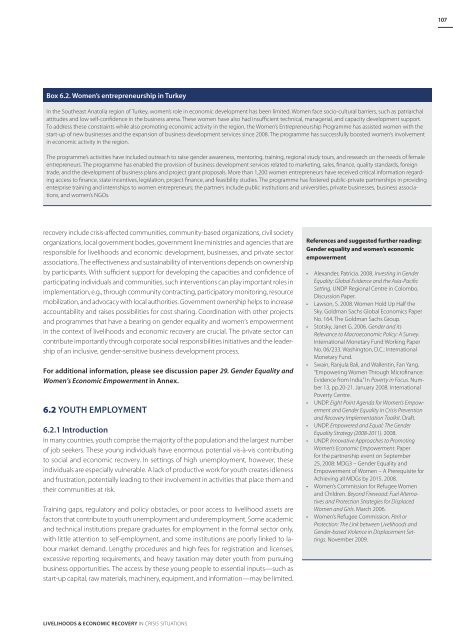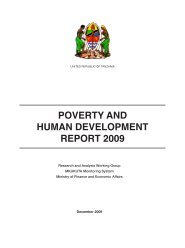Download PDF (4.08 MB) - ReliefWeb
Download PDF (4.08 MB) - ReliefWeb
Download PDF (4.08 MB) - ReliefWeb
Create successful ePaper yourself
Turn your PDF publications into a flip-book with our unique Google optimized e-Paper software.
107<br />
Box 6.2. Women’s entrepreneurship in Turkey<br />
In the Southeast Anatolia region of Turkey, women’s role in economic development has been limited. Women face socio-cultural barriers, such as patriarchal<br />
attitudes and low self-confidence in the business arena. These women have also had insufficient technical, managerial, and capacity development support.<br />
To address these constraints while also promoting economic activity in the region, the Women’s Entrepreneurship Programme has assisted women with the<br />
start-up of new businesses and the expansion of business development services since 2008. The programme has successfully boosted women’s involvement<br />
in economic activity in the region.<br />
The programme’s activities have included outreach to raise gender awareness, mentoring, training, regional study tours, and research on the needs of female<br />
entrepreneurs. The programme has enabled the provision of business development services related to marketing, sales, finance, quality standards, foreign<br />
trade, and the development of business plans and project grant proposals. More than 1,200 women entrepreneurs have received critical information regarding<br />
access to finance, state incentives, legislation, project finance, and feasibility studies. The programme has fostered public-private partnerships in providing<br />
enterprise training and internships to women entrepreneurs; the partners include public institutions and universities, private businesses, business associations,<br />
and women’s NGOs.<br />
recovery include crisis-affected communities, community-based organizations, civil society<br />
organizations, local government bodies, government line ministries and agencies that are<br />
responsible for livelihoods and economic development, businesses, and private sector<br />
associations. The effectiveness and sustainability of interventions depends on ownership<br />
by participants. With sufficient support for developing the capacities and confidence of<br />
participating individuals and communities, such interventions can play important roles in<br />
implementation, e.g., through community contracting, participatory monitoring, resource<br />
mobilization, and advocacy with local authorities. Government ownership helps to increase<br />
accountability and raises possibilities for cost sharing. Coordination with other projects<br />
and programmes that have a bearing on gender equality and women’s empowerment<br />
in the context of livelihoods and economic recovery are crucial. The private sector can<br />
contribute importantly through corporate social responsibilities initiatives and the leadership<br />
of an inclusive, gender-sensitive business development process.<br />
For additional information, please see discussion paper 29. Gender Equality and<br />
Women’s Economic Empowerment in Annex.<br />
6.2 Youth Employment<br />
6.2.1 Introduction<br />
In many countries, youth comprise the majority of the population and the largest number<br />
of job seekers. These young individuals have enormous potential vis-à-vis contributing<br />
to social and economic recovery. In settings of high unemployment, however, these<br />
individuals are especially vulnerable. A lack of productive work for youth creates idleness<br />
and frustration, potentially leading to their involvement in activities that place them and<br />
their communities at risk.<br />
Training gaps, regulatory and policy obstacles, or poor access to livelihood assets are<br />
factors that contribute to youth unemployment and underemployment. Some academic<br />
and technical institutions prepare graduates for employment in the formal sector only,<br />
with little attention to self-employment, and some institutions are poorly linked to labour<br />
market demand. Lengthy procedures and high fees for registration and licenses,<br />
excessive reporting requirements, and heavy taxation may deter youth from pursuing<br />
business opportunities. The access by these young people to essential inputs—such as<br />
start-up capital, raw materials, machinery, equipment, and information—may be limited.<br />
References and suggested further reading:<br />
Gender equality and women’s economic<br />
empowerment<br />
• Alexander, Patricia. 2008. Investing in Gender<br />
Equality: Global Evidence and the Asia-Pacific<br />
Setting. UNDP Regional Centre in Colombo.<br />
Discussion Paper.<br />
• Lawson, S. 2008. Women Hold Up Half the<br />
Sky. Goldman Sachs Global Economics Paper<br />
No. 164. The Goldman Sachs Group.<br />
• Stotsky, Janet G. 2006. Gender and its<br />
Relevance to Macroeconomic Policy: A Survey.<br />
International Monetary Fund Working Paper<br />
No. 06/233. Washington, D.C.: International<br />
Monetary Fund.<br />
• Swain, Ranjula Bali, and Wallentin, Fan Yang.<br />
“Empowering Women Through Microfinance:<br />
Evidence from India.” In Poverty in Focus. Number<br />
13, pp.20-21. January 2008. International<br />
Poverty Centre.<br />
• UNDP. Eight Point Agenda for Women’s Empowerment<br />
and Gender Equality in Crisis Prevention<br />
and Recovery Implementation Toolkit. Draft.<br />
• UNDP. Empowered and Equal: The Gender<br />
Equality Strategy (2008-2011). 2008.<br />
• UNDP. Innovative Approaches to Promoting<br />
Women’s Economic Empowerment. Paper<br />
for the partnership event on September<br />
25, 2008: MDG3 – Gender Equality and<br />
Empowerment of Women – A Prerequisite for<br />
Achieving all MDGs by 2015. 2008.<br />
• Women’s Commission for Refugee Women<br />
and Children. Beyond Firewood: Fuel Alternatives<br />
and Protection Strategies for Displaced<br />
Women and Girls. March 2006.<br />
• Women’s Refugee Commission. Peril or<br />
Protection: The Link between Livelihoods and<br />
Gender-based Violence in Displacement Settings.<br />
November 2009.<br />
Livelihoods & Economic Recovery in Crisis Situations





